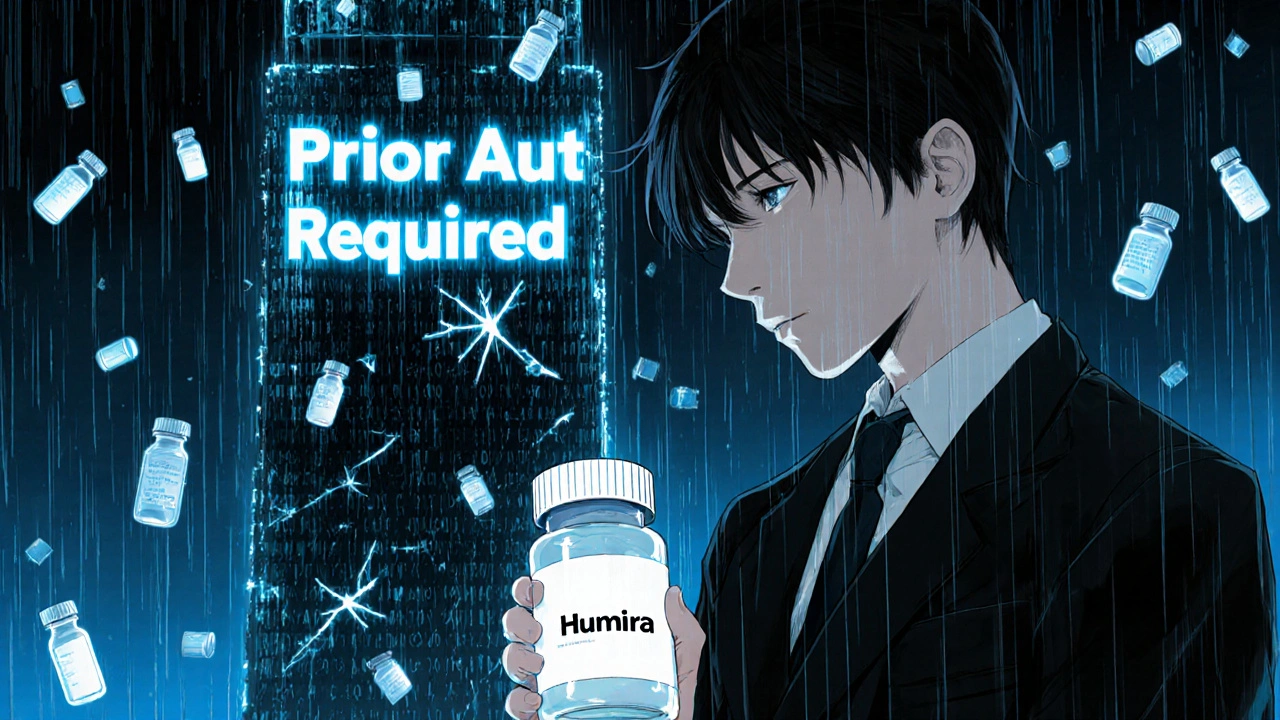When you’re prescribed a biologic drug like Humira for rheumatoid arthritis or Crohn’s disease, you might assume your insurance will cover it - but what if your plan covers the cheaper biosimilar version the same way? In 2025, most insurance plans still treat biosimilars and their brand-name counterparts as equals on the same tier, even though biosimilars cost 10-33% less. That means patients often pay nearly the same out-of-pocket price whether they take the original or the generic-like alternative. And if your plan requires prior authorization just to get started, you could be stuck waiting weeks just to begin treatment.
Why Biosimilars Are Different From Generics
Biosimilars aren’t like regular generic pills. You can’t just swap them in like you would with a generic version of metformin or lisinopril. Biologics - the original drugs biosimilars copy - are made from living cells, not chemicals. That makes them far more complex. Even tiny differences in how they’re manufactured can affect how they work in the body. That’s why the FDA requires biosimilars to prove they’re highly similar to the reference product, with no meaningful differences in safety or effectiveness. Still, they’re not exact copies. And that complexity is one reason insurers treat them differently.As of 2025, the FDA has approved over 70 biosimilars, but only about 40 are actually on the market. The biggest success story so far has been adalimumab biosimilars - copies of Humira. Eight of them are available, yet less than half of Medicare Part D plans cover any of them. Even when they do, they’re usually placed on the same high-cost specialty tier as Humira itself. That defeats the whole purpose: lowering costs for patients and the system.
How Drug Tiers Work - And Why They’re Holding Back Biosimilars
Most insurance plans use a tier system to control drug costs. Tier 1 is usually generic pills with low copays. Tier 4 or 5 is where biologics live - expensive drugs that require you to pay a percentage of the cost, not a flat fee. For Humira, which costs around $5,000 per month, that means a 33% coinsurance rate could leave you paying over $1,600 out of pocket each month.Here’s the problem: 99% of Medicare Part D plans put biosimilars on the same tier as Humira. Only 1.5% of plans put biosimilars on a lower tier to encourage switching. That’s not just lazy policy - it’s a missed opportunity. If a biosimilar costs $3,500 instead of $5,000, and you’re paying 33% coinsurance, your monthly cost drops from $1,650 to $1,155. That’s a $500 difference. But if your plan doesn’t make that difference obvious, why would you or your doctor bother?
Even worse, some insurers don’t cover biosimilars at all. A 2023 report found that major PBMs like UnitedHealthcare, CVS, and Cigna didn’t include any insulin biosimilars on their formularies, even though eight adalimumab biosimilars were already available. That’s not a clinical decision - it’s a business one. Biologic manufacturers pay rebates to insurers to stay on formularies. Those rebates often outweigh the savings from switching to biosimilars. So plans keep the expensive brand drug on the list - and leave the cheaper option out.
Prior Authorization: The Bureaucratic Wall
If you’re lucky enough to have a biosimilar covered, you still have to jump through hoops. Nearly all plans - 98.5% - require prior authorization for both Humira and its biosimilars. That means your doctor has to submit paperwork proving you’ve tried other treatments first, documenting your diagnosis, and sometimes even showing you can’t tolerate the brand drug.Approval can take 3 to 14 days. During that time, you’re not getting treated. For someone with severe arthritis or inflammatory bowel disease, those weeks mean more pain, more flare-ups, and more time off work. A 2024 survey found that 78% of rheumatologists spend 3-5 hours a week just filling out prior auth forms. That’s not time spent with patients. That’s time spent fighting insurance companies.
Some plans add step therapy on top of prior auth. That means you have to try the biosimilar first - even if your doctor believes the brand drug is better for you. One case study documented a patient with rheumatoid arthritis who waited 28 days because the plan forced her to try a biosimilar first. By the time she got approved for Humira, her condition had worsened. That’s not patient-centered care. That’s cost-shifting disguised as protocol.

Why PBMs Are Starting to Change - But Not Because They Care
There’s a quiet shift happening. Some pharmacy benefit managers (PBMs) are now excluding Humira entirely from their formularies. Express Scripts, OptumRx, and CVS Caremark all removed Humira from their standard commercial plans in 2025. Instead, they’re pushing patients toward biosimilars by placing them on preferred tiers - sometimes Tier 3 instead of Tier 4. That means lower coinsurance, lower out-of-pocket costs, and faster access.This isn’t altruism. It’s strategy. By removing the expensive brand drug, PBMs force patients to use biosimilars - and they still get rebates from biosimilar makers. It’s a way to cut costs without looking like they’re cutting care. In fact, Express Scripts now offers multiple adalimumab biosimilars on Tier 3 with 25% coinsurance - a small but real incentive compared to the 33% charged for non-preferred biologics.
This approach is working. Biosimilar use in the U.S. jumped from 12% of the biologics market in 2022 to 18% in 2024. But it’s still far behind Europe, where biosimilars make up over 80% of the market. Why? Because European insurers don’t just cover biosimilars - they actively steer patients toward them. In the U.S., we’re still stuck in a middle ground: technically available, but not encouraged.
What This Means for Patients
If you’re on a biologic right now, here’s what you need to do:- Check your plan’s formulary. Look up your drug - and all its biosimilar versions - on your insurer’s website. Don’t trust your pharmacy’s word. Formularies change every year.
- Ask if your biosimilar is on a lower tier. If it’s on the same tier as the brand drug, ask your doctor to appeal. Some plans will change coverage if you provide documentation that the biosimilar is equally effective and cheaper.
- Know your prior auth requirements. Keep copies of all your medical records, lab results, and treatment history. The more you can prove you’ve tried other options, the faster you’ll get approved.
- Ask about patient assistance programs. Many biosimilar manufacturers offer co-pay cards or free drug programs. These can slash your monthly cost to under $100 - even if your insurance doesn’t help.
And if you’re on Medicare Part D? You’re in a tough spot. Most plans still treat biosimilars and brand drugs the same. But starting in 2025, CMS is requiring plans to report how they cover biosimilars - including tier placement and prior auth rules. That means pressure is building. Change is coming - slowly.

The Bigger Picture: Billion in Savings, If We Let It Happen
The Congressional Budget Office estimates biosimilars could save the U.S. healthcare system $54 billion over the next decade. That’s enough to cover millions of prescriptions, reduce premiums, and ease pressure on Medicare. But that only happens if insurers stop treating biosimilars like second-class drugs.Right now, the system is designed to protect the status quo. Biologics make billions for manufacturers. PBMs profit from rebates. Pharmacies get paid the same whether they dispense a $5,000 drug or a $3,500 one. Patients are left paying the difference - in money, in time, and in pain.
It doesn’t have to be this way. If insurers placed biosimilars on lower tiers, required less paperwork, and stopped forcing step therapy, adoption would skyrocket. Patients would get better care faster. The system would save money. And the only losers would be outdated business models.
Are biosimilars as safe as the original biologic drugs?
Yes. The FDA requires biosimilars to undergo rigorous testing to prove they’re highly similar to the reference biologic in terms of safety, purity, and potency. They’re not identical - but they’re not less safe. In fact, biosimilars like adalimumab biosimilars have been used by millions of patients in Europe for over a decade with no increase in adverse events. In the U.S., post-market monitoring shows similar safety profiles to the original drugs.
Why don’t insurance plans put biosimilars on lower tiers?
Most plans don’t because the original drug manufacturers pay large rebates to keep their products on formularies. These rebates often exceed the savings from switching to a cheaper biosimilar. So even though a biosimilar might cost $1,500 less per month, the insurer still makes more money keeping the brand drug on the list. That’s why only 1.5% of plans place biosimilars on lower tiers - it’s not about clinical value, it’s about financial incentives.
Can my pharmacist switch me to a biosimilar without my doctor’s approval?
Only if the biosimilar has an "interchangeable" designation from the FDA - and even then, it’s rare. As of 2025, only a few adalimumab biosimilars have this status, and only for low-concentration formulations. Most biosimilars still require a new prescription from your doctor. In most states, pharmacists can’t substitute a biosimilar for a brand drug without explicit permission. This is a major barrier to faster adoption.
How long does prior authorization take for biosimilars?
Typically 3 to 14 business days, depending on your plan and how complete your paperwork is. Some plans have automated systems that approve in 48 hours if all criteria are met. Others require manual review, which can drag on for weeks. If your doctor’s office doesn’t follow up, your approval can get lost. Always ask for a tracking number and call the insurer directly after five business days if you haven’t heard back.
Can I appeal if my insurance denies coverage for a biosimilar?
Yes. You have the right to appeal. Start by requesting a written denial letter from your insurer. Then, have your doctor write a letter of medical necessity explaining why the biosimilar is appropriate - or why you need the brand drug instead. Many appeals are successful, especially if you can show that the biosimilar is covered by other plans or that you’ve tried other treatments already. Don’t give up after the first denial.
What’s the difference between a biosimilar and a generic drug?
Generics are exact chemical copies of small-molecule drugs like aspirin or statins. Biosimilars are highly similar - but not identical - copies of complex biologic drugs made from living cells. Because they’re more complex, biosimilars require more testing and can’t be labeled as "generic." They’re also more expensive to produce, which is why they cost less than the brand drug but still more than traditional generics.
What Comes Next?
The Inflation Reduction Act gives CMS new power to enforce fair formulary practices. Starting in 2026, plans that don’t cover biosimilars or that place them on higher tiers than the reference product could face penalties. That’s the first real incentive for change. Meanwhile, more PBMs are dropping the brand drugs entirely - not because they care about patients, but because it’s cheaper for them.For patients, the path forward is clear: know your coverage, ask questions, fight denials, and use manufacturer assistance programs. For the system, the path is harder - but necessary. Biosimilars aren’t a niche option. They’re the future of affordable biologic care. If we keep treating them like an afterthought, we’ll keep paying more - and patients will keep suffering longer.





Scott Macfadyen
November 18, 2025 AT 04:08Just got denied for my Humira biosimilar because my plan says I need to try the brand first. I’ve been on biologics for 8 years. My joints are screaming. The paperwork took 11 days. My doctor’s office spent 3 hours on it. And for what? So some PBM executive can keep his bonus? This isn’t healthcare. It’s a casino where the house always wins.
Chloe Sevigny
November 19, 2025 AT 19:32The structural heterogeneity of biosimilars, while empirically validated for clinical equivalence, remains a regulatory artifact of pharmaceutical capitalism. The FDA’s ‘highly similar’ standard is a linguistic euphemism for ‘close enough to profit from.’ The tier parity is not an oversight-it’s a calculated incentive structure wherein rebate economics supersede pharmacoeconomic efficiency. The 1.5% adoption rate on lower tiers is not a failure of policy, but a triumph of rent-seeking behavior.
Denise Cauchon
November 20, 2025 AT 19:59Canada’s system is way better than this mess. We don’t make people beg for their own medicine. Here, if you can’t afford your drug, you just die quietly. Meanwhile, the U.S. is out here fighting over $500 a month while Big Pharma laughs all the way to the bank. I’m Canadian, and I’m embarrassed for you. This isn’t freedom. It’s exploitation dressed up as ‘choice.’
Also, I saw a guy on the news who had to wait 28 days for his Humira because they made him try the biosimilar first. He ended up in the ER. That’s not healthcare. That’s cruelty with a spreadsheet.
Andrea Johnston
November 22, 2025 AT 05:07Let me guess-your doctor told you to ‘just switch’ to the biosimilar because ‘it’s the same.’ Newsflash: it’s not the same. It’s similar. And if your insurance treats them as identical, they’re either lying or clueless. I had a flare-up because my plan auto-switched me without telling me. I ended up in the hospital. Don’t let anyone tell you biosimilars are ‘just generics.’ They’re not. And if your plan doesn’t treat them like the complex, high-risk drugs they are, they’re not doing their job.
Victoria Malloy
November 24, 2025 AT 02:17My friend got her biosimilar approved after 6 appeals. She’s been pain-free for 8 months now. It’s exhausting, but it’s worth it. Don’t give up. Call your insurer every 3 days. Save every email. Ask your doctor to write a letter. And if you’re on Medicare, join a patient advocacy group-they’ll help you fight. You’re not alone in this.
Alex Czartoryski
November 24, 2025 AT 10:01Bro, I switched to the biosimilar last year. Paid $120 instead of $1,600. My doctor didn’t even blink. My insurance didn’t make me jump through hoops. Why? Because I called them and said, ‘I’m switching whether you like it or not.’ They changed my tier within 48 hours. Stop waiting for permission. Just ask. And if they say no, ask again. Loudly.
Gizela Cardoso
November 25, 2025 AT 14:05I work in a rheumatology clinic. We’ve seen biosimilars cut patient out-of-pocket costs by 60-70% when they’re on the right tier. But we also see how much stress it adds-patients skipping doses because they’re scared of the bill, or waiting weeks for approval while their disease progresses. It’s heartbreaking. The system’s broken, but we’re trying to fix it one patient at a time. Keep pushing. Your voice matters.
Erica Lundy
November 27, 2025 AT 08:27The current regulatory and reimbursement architecture for biosimilars in the United States reflects a profound misalignment between pharmacological reality and economic incentive structures. The persistence of tier parity, coupled with the institutionalized reliance on rebate-driven formulary placement, constitutes a systemic failure of value-based care. The Congressional Budget Office’s $54 billion projection is not aspirational-it is mathematically inevitable, provided that structural barriers to biosimilar adoption are dismantled. Until then, the burden of inefficiency is externalized onto the most vulnerable stakeholders: patients, clinicians, and the integrity of the therapeutic relationship.